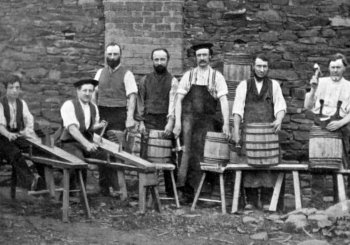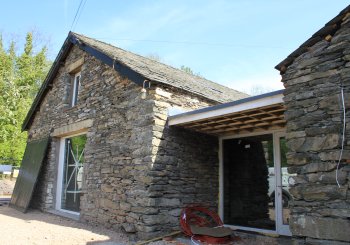
"Daye Barker & Co."
gunpowder packaging label
History Of The Site
Since the mid eighteenth century, the area now known as "South Lakeland" has had seven gunpowder mills operating in it. The oldest was "Old Sedgwick" established in 1746, while the youngest and most modern was "Black Beck" at Bouth, established in 1860.
The "Low Wood" works were built on the site of an iron furnace owned by Isaac Wilkinson (the father of John Wilkinson, and renowned iron master of Backbarrow and Iron Bridge, and builder of the worlds first iron boat), with a license to manufacture gunpowder at the site being granted on the 22nd of October 1798.
The partners in this venture were Mr Daye Barker (a clock maker from Wigan, and previous partner in the Backbarrow cotton mill), Mr James King (an estate owner from Finsthwaite), Mr Christopher Wilson Jr. (a member of a Kendal banking family), and Captain James Foyer (a retired ships captain, who amongst other roles acted as the company agent in Liverpool).
The first sales of their gunpowder was "Africa" powder and ships armaments. In those days the River Leven was navigable up to Low Wood, enabling product and raw materials to be transported on the river in "flatties" - shallow draft, single masted vessels that were used extensively in Morecambe Bay.
Finished gunpowder was either stored at the service magazine in Roudsea wood (at the Frith at Greenodd), or in the works magazine at the eastern end of the site. However, the works magazine had to be relocated due to the opening of the Furness Railways branch line from Ulverston to Lakeside in 1868, as it was felt there was risk of sparks from the engines cause an explosion in the powder buildings only 200 yards away on the opposite side of the river.

Site plan of the gunpowder works
from 1846 when planning applications for the
Furness Railway were being made.
Making Gunpowder
Like all gunpowder works, the Low Wood site had many small buildings on it (approximately 100 in 1882), connected by a tramway, with large separations between them. Accidents were relatively common, and so each building only had 3 stone walls, with the roof and front wall being constructed from wooden panelling, to minimise damage to the structure in case of an explosion.
In the "Preparing House", the three raw ingredients of gunpowder (Charcoal, Saltpetre and Sulphur) were brought together and ground into a fine powder, and then correctly mixed to produce an "unripe" (or "green") charge.
This powder was then passed through Incorporating Mills to ensure it was thoroughly combined and of the correct density. A little water was usually added to help hold the charge together and dissolve some of the ingredients into the charcoal. The Incorporating Mills usually consisted of two large limestone vertical grind-wheels rolling in a circular motion around bed-stone, and driven from a water-wheel on the outside of the building.
After milling, the amalgamated power, now know as a "ripe" charge, was then pressed into hard dense slabs (known as "press cake") which were then subsequently broken down into grains of the required size, through a process known as "corning" (or "granulating"). These were dangerous tasks, and records record several explosions on the site in 1863 and 1903.
The small but angular gains were next smoothed, through a process known as "Glazing", where they would be tumbled in wooden barrels for several hours, with small amounts of graphite powder being added.
Once glazed, the gunpowder was then dried in "Stove" houses to remove and moisture left over from the previous processes, before being sent to the "Dusting" house where under or over sized grains were removed.
Finally, the now complete powder grains were ready to be weighed out and packed into barrels or blasting cartridges for storage and sale.

Low Wood gunpowder van.
Mr Pennington driving the horse named 'Star', c.1930
(courtesy R. Mein Collection)
Transportation of the Gunpowder
With the coming of the railway to Haverthwaite, tram lines were laid on all the works internal cart tracks, and an 80 foot long girder bridge was constructed to cross the River Leven. The narrow gauge box cars and wagons that were pulled on this internal rail network were collectively called "Trams" by the workforce, possibly because the rails were second hand tram lines bought from various city councils including Preston and Blackpool.
Low Wood produced about 20 tons of powder a week to be transported by rail. Horses (shod in copper or brass shoes, to eliminate the risk of sparks and explosion) were used to pull the trams across the river bridge and then up the steep gradient to Haverthwaite station (across the road that is now the A590). To achieve this, it was necessary to have three turns in the tramline traversing the hill between the bridge and station, and once the powder was unloaded the horses were unhitched and allowed to make their own way back to the mills, while the trams free-wheeled back down with the driver operating a handbrake to check the speed.

Coopers manufacturing barrels outside what is now 'Unit 2'.
(courtesy R. Mein Collection)
A Dangerous Business
Gunpowder manufacture was a dangerous business, and over an 80 year period there were a recorded 21 fatalities on the site. Despite this, Low Wood was considered as one of the safer gunpowder works.
By the 1860s, the demand for black powder began to be superseded by more modern explosives. Low Wood and the nearby Black Beck mills were sold to "W. H. Wakefield and Co" in 1882 (the company which also owned the Sedgewick and Gatebeck mills), and with the end of world war one in 1918, the demand for every kind of explosive fell to an all time low. The company was merged with the Nobel organisation and the business was restructured which resulted in the closure of several mills and the inevitable loss of jobs.
In 1926 the remaining mills, including Low Wood and Black Beck, became part of Imperial Chemical Industries (ICI), and as much of the demand of the product was now for coal mining, stone and slate quarries, and civil engineering, ICI carried out an extensive modernisation programme in 1928. However, even by today's standard, this was a major undertaking and very costly exercise that probably never fully paid for itself, as production in Low Wood ceased in 1935.

Building work on the Clock Tower site, May 2011.
A New Future
With its closure, the small production buildings on the site were destroyed by ICI for safety reasons, leaving only the walls standing. However, the main Clock Tower building was left intact and after being commandeered during the Second World War to house American troops and supplies, it has since seen a variety of uses including storage and retail.
In 2010, redevelopment work started to convert and preserve this Grade II* listed building into a development blending the traditional style and heritage of the area with everything you would expect from a modern office environment.
Portions of the historical text supplied courtesy of Mr Ron Mein.
Further information on the Leven Valley history.
Want To Find Out More ?
Download The Clock Tower Brochure (3.5Mb).
To view this document you will need Adobe Acrobat Reader software installed on your computer.
|
This will open our Facebook page in a seperate browser window. |
To get the latest news, subscribe to '@clocktower6'. |
